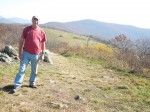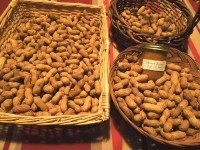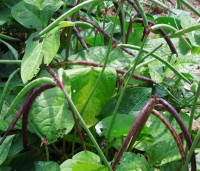 This year I tried out two distinctively Southern crops I’d never grown before: cowpeas and peanuts. Cowpeas, also known as southern peas, were brought to the American south by enslaved Africans. They come in many varieties, the most well-known being black-eyed peas. They have a high protein content and are easy to grow. Being a legume, an added benefit is that they fix nitrogen in the soil. I chose to grow a variety from Baker Creek called Six Week Purple-Hull Cowpea. A package of seeds produced about five cups of dry beans. A great thing about cowpeas is that if you just leave them on the plant until the pods are dry, they’re pretty much instantly ready for storage. This one has a particularly nice buttery and nutty taste.
This year I tried out two distinctively Southern crops I’d never grown before: cowpeas and peanuts. Cowpeas, also known as southern peas, were brought to the American south by enslaved Africans. They come in many varieties, the most well-known being black-eyed peas. They have a high protein content and are easy to grow. Being a legume, an added benefit is that they fix nitrogen in the soil. I chose to grow a variety from Baker Creek called Six Week Purple-Hull Cowpea. A package of seeds produced about five cups of dry beans. A great thing about cowpeas is that if you just leave them on the plant until the pods are dry, they’re pretty much instantly ready for storage. This one has a particularly nice buttery and nutty taste.
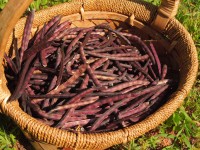
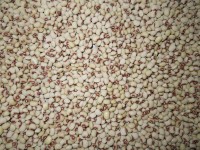 Â
 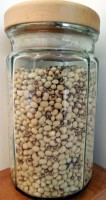
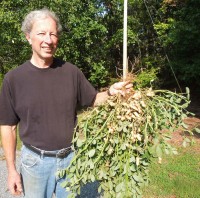 Peanuts originated in South America; the Spanish encountered them first in what is today Mexico. It’s been surprising to me how many people don’t know that peanuts grow mainly underground–I learned this early living in Tanzania, where peanuts are known as groundnuts. The nuts grow mostly underground on string-like tethers from the many branches of the plant. They take at least four months to mature, but they are heat and drought tolerant. To harvest, one loosens the plant with a pitchfork and then pulls it out. A single plant can have 50-70 peanuts, although some may have considerably less. You leave the nuts on the plant to begin drying for a few days, then remove them and dry them on a screen for about three weeks.  After all the nuts have been cured, roasted peanuts and homemade peanut butter are on the agenda!
Peanuts originated in South America; the Spanish encountered them first in what is today Mexico. It’s been surprising to me how many people don’t know that peanuts grow mainly underground–I learned this early living in Tanzania, where peanuts are known as groundnuts. The nuts grow mostly underground on string-like tethers from the many branches of the plant. They take at least four months to mature, but they are heat and drought tolerant. To harvest, one loosens the plant with a pitchfork and then pulls it out. A single plant can have 50-70 peanuts, although some may have considerably less. You leave the nuts on the plant to begin drying for a few days, then remove them and dry them on a screen for about three weeks.  After all the nuts have been cured, roasted peanuts and homemade peanut butter are on the agenda!
Of course, the classic crop of Southern planters, from colonial days well into the twentieth century, was tobacco, which devastates the soil, quite apart from its other pernicious effects. Decaying tobacco barns still dot the countryside here, but Nelson County is happily making an agricultural transition to healthier and more varied harvests. Just today we bought a quart of sorghum molasses at the annual Sorghum-making festival down the road, and a bushel of Fuji apples at a nearby orchard!
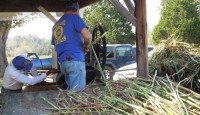
Sorghum stalks being fed into press;
the resulting juice is then boiled down




